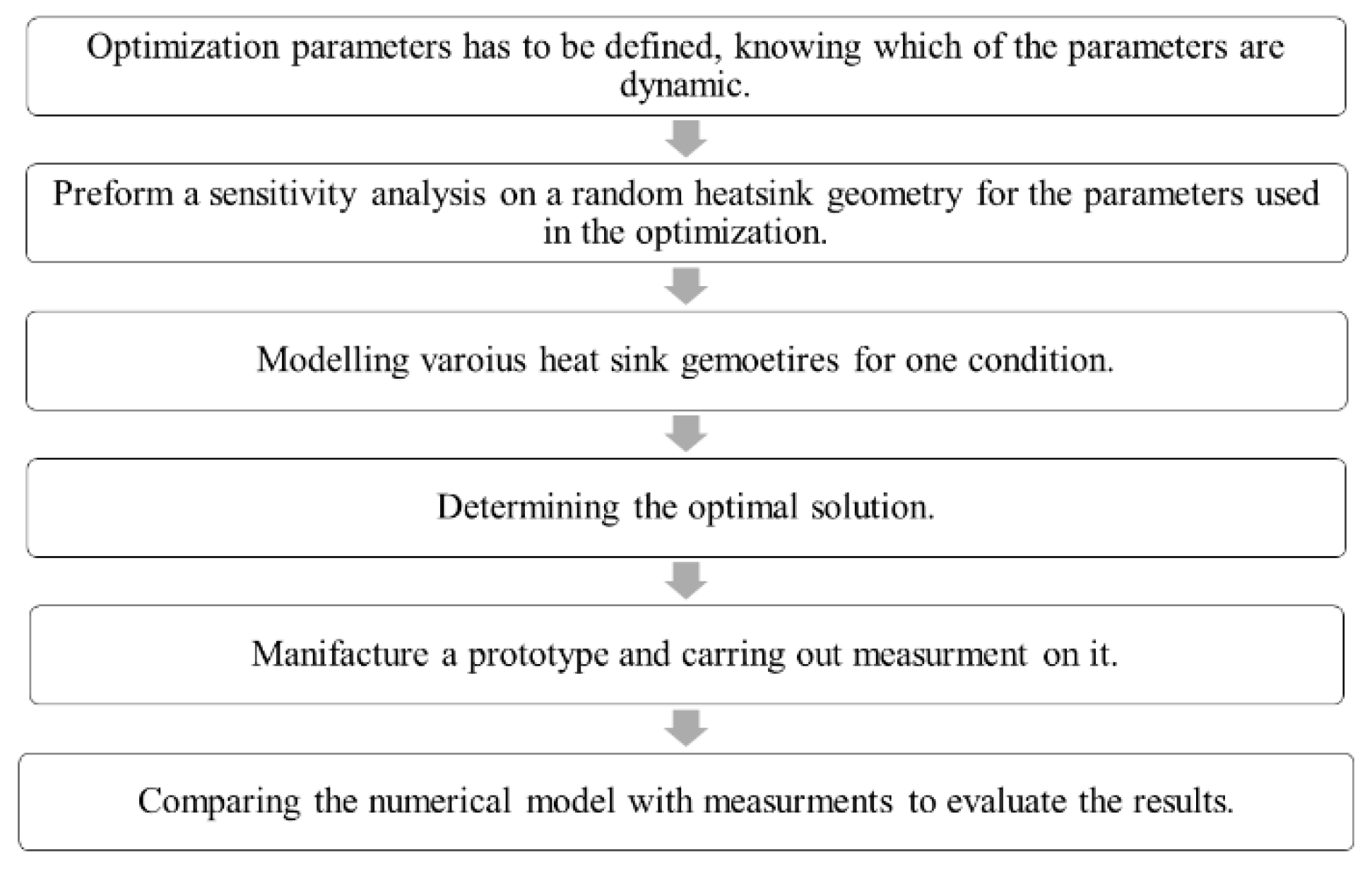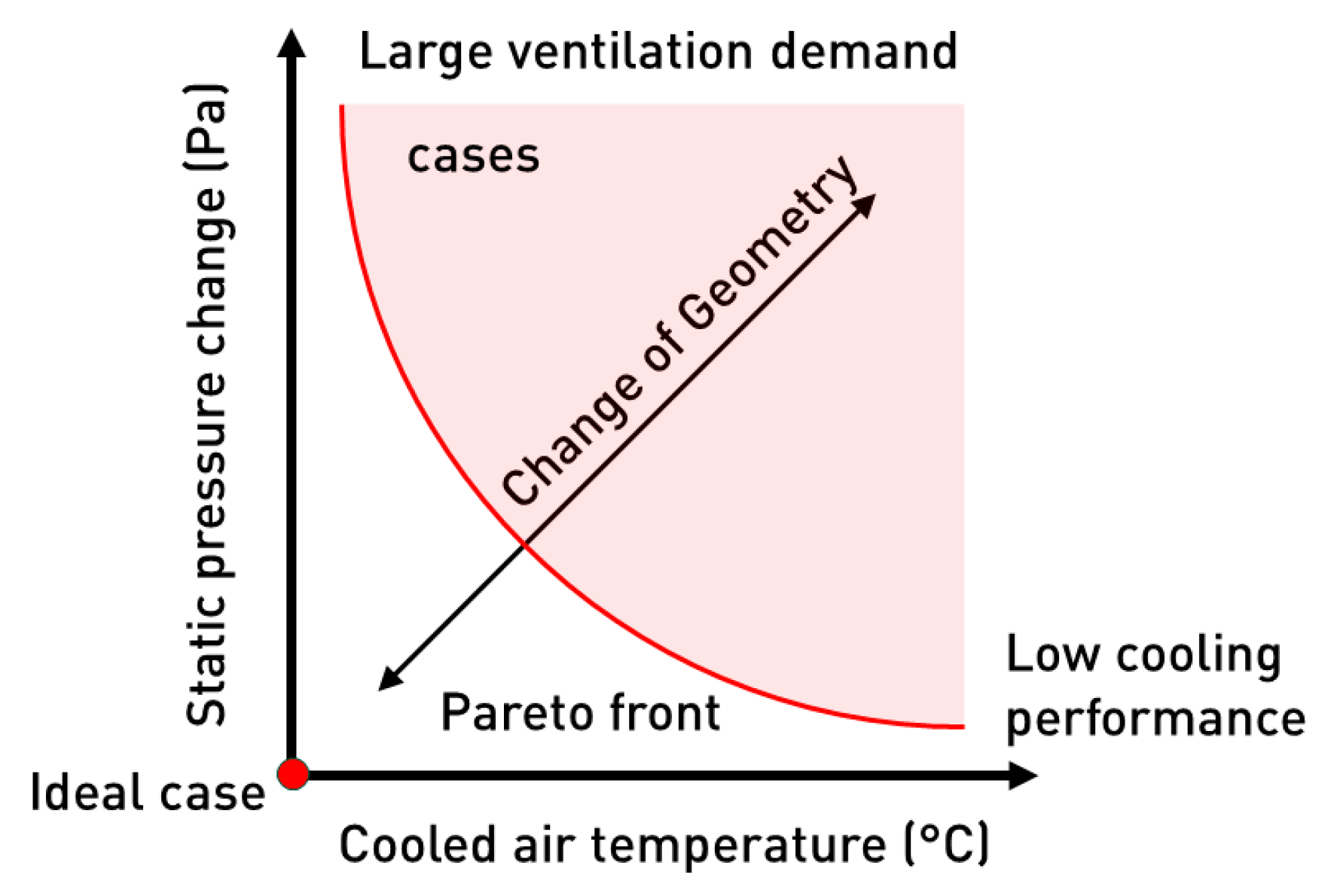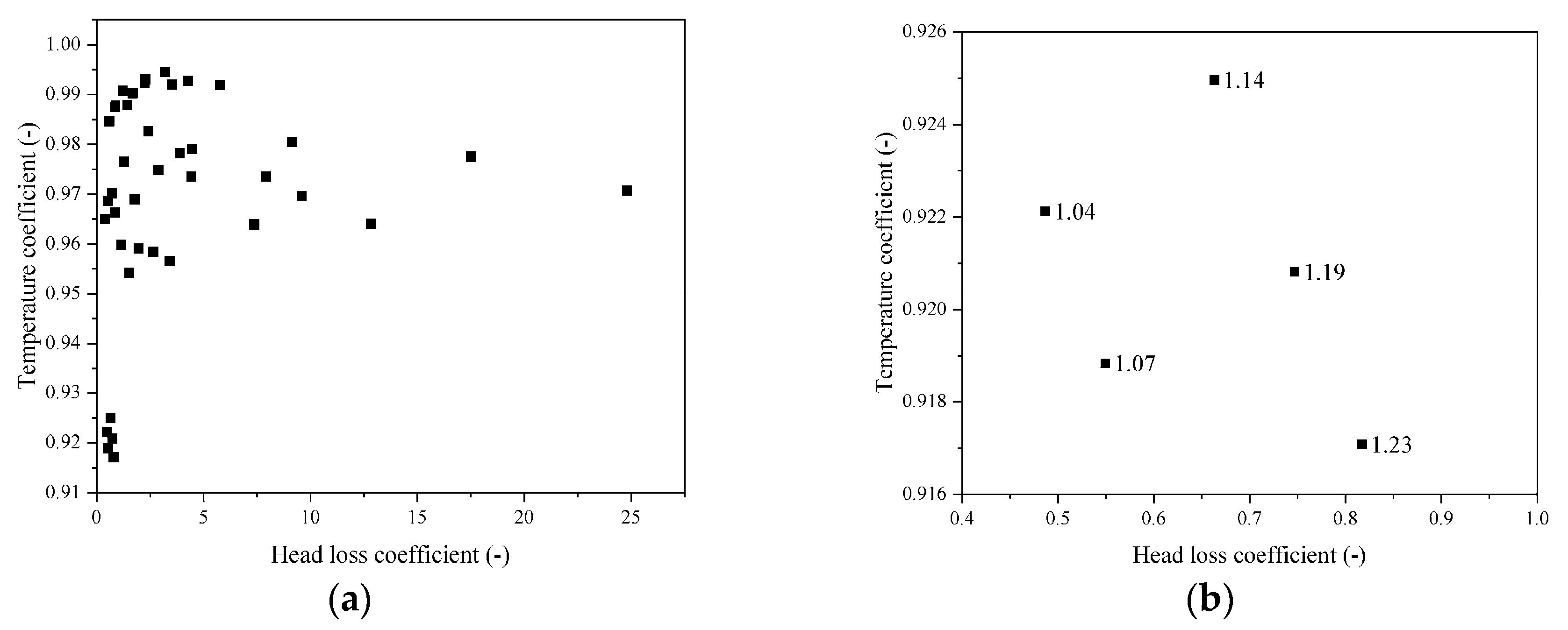Heat Sink Shape and Topology Optimization with Pareto-Vector Length Optimization for Air Cooling
Abstract
:1. Introduction
1.1. Thermoelectric Cooling
1.2. Moist Air
1.3. Head Loss Coefficient
1.4. Temperature Coefficient
1.5. Goals
2. Materials and Methods
2.1. Pareto-Vector Length Optimization
- all of the optimization parameters have to be minimised;
- these parameters are equally important;
- on the Pareto front there should be only one favourable point;
- the favourite point is the closest to the origin of the coordinate system;
- the distance between this Pareto optimum and the origin, gives a vector length and the shortest vector length should be the “optimum vector length”.
2.2. Numerical Setup
2.2.1. First Set of Simulations
2.2.2. Second Set of Simulations
2.2.3. Third Set of Simulations
2.2.4. Mesh and Turbulence
2.3. Prototype Measurment
- (1)
- Flow measurements were taken (Δp and v) while only the fan and the pump of the cooling tank were on.
- (2)
- Temperature and relative humidity values before (Tinlet; RHinlet) and after (Toutlet; RHoutlet) the heat sink measurements were logged every 10 s. The logging started 10 min before the application of the cooling to examine the measurement errors.
- (3)
- The airflow was cooled for 2 h. During the cooling the heat sink surface temperature (Tcold); voltage (U) and power demand (P) values were noted in every minute.
- (4)
- When the measurement was over, it was examined when did the flow reached a quasi-steady state. The values that were collected during the quasi-steady state were averaged.
3. Results and Discussion
3.1. Sensitivity Analysis
3.2. Shape and Topology Optimization
3.3. Measurements on the Favoured Geometry
- the moisture content decreased;
- homogeneity of the model changed by about Δx = 8 × 10−5 kg kg−1;
- the effective magnitude of the Qcold has been reduced;
- the TEC devices also reduced the droplet temperatures instead of the air.
3.4. Comparison
4. Conclusions
- With the help of the sensitivity analysis, it was concluded that between v = 3–5 m s−1; RH 30–70%; Tinlet = 26–38 °C; the head loss coefficient deviates by ±4.26% and the temperature coefficient by ±4.34%.
- With the sensitivity analysis the optimization was done with only one set of boundary conditions, however, due to this sensitivity the uncertainty of the Pareto-vector length is 2.7%.
- Pareto-vector length optimum geometry obtained when a single 6 mm wide thin fin is placed in a 40 mm by 40 mm large rectangular duct.
- A prototype of the heat sink was manufactured and measured at RH = 45.15% and Tinlet = 17.08 °C environment. During the experiment notable condensation occurred on the heat sink.
- When the simulation was compared with measurement on the prototype, significant deviation occurred, which could be explained by the condensed droplets on the surface of the heat sink.
- From the measured air properties, the decreased sensible heat was calculated and applied in the comparison model. When the outlet temperatures were compared the difference was 3%.
- The condensation becomes a limitation for the model since the droplet formation could increase the complexity of the model. In addition, it imposes unwanted computational demands.
- This model can be accurate if the properties of the air at the outlet do not fall below the dew point.
- The accuracy of the optimization however is not affected by the phase change.
- For a 17 m3 h−1 air flow, the type TEC1-12706 devices showed low performance, yet with more heat sinks connected together and solving the drain it could be an alternative method for moist air cooling.
Funding
Acknowledgments
Conflicts of Interest
Nomenclature
| h | enthalpy (kJ kg−1) |
| I | current (A) |
| P | power usage (W) |
| p | pressure (Pa) |
| Qcold | cooling power (W) |
| Re | electric resistance (Ω) |
| RH | relative humidity (%) |
| Rt | thermal resistance (K W−1) |
| Ru = 8314.3 J kg−1 | universal gas constant |
| S | Seebeck coefficient (V K−1) |
| T | temperature (K) or (°C) |
| U | voltage (V) |
| v | velocity (m s−1) |
| x | absolute humidity (kg kg−1) |
| ρ | density (kg m−3) |
Subscripts
| Cold | cold side of the TEC device |
| DA | dry air |
| Inlet | parameter at the inlet of the duct |
| M | measured |
| MA | moist air |
| Max | maximum |
| Outlet | parameter at the outlet of the duct |
| T | theoretical |
| Target | targeted temperature |
| TEC | corresponding to the TEC device |
| V | vapour |
| Warm | warm side of the TEC device |
References
- Joas, F.; Pahle, M.; Flachsland, C.; Joas, A. Which goals are driving the Energiewende? Making sense of the German Energy Transformation. Energy Policy 2016, 95, 42–51. [Google Scholar] [CrossRef]
- Hui, H.; Ding, Y.; Liu, W.; Lin, Y.; Song, Y. Operating reserve evaluation of aggregated air conditioners. Appl. Energy 2017, 196, 218–228. [Google Scholar] [CrossRef]
- Szabó, G.L.; Kalmár, F. Investigation of energy and exergy performances of radiant cooling systems in buildings–A design approach. Energy 2019. [Google Scholar] [CrossRef]
- Szabó, G.L.; Kalmár, F. Parametric analysis of buildings’ heat load depending on glazing—Hungarian case study. Energies 2018, 11, 3291. [Google Scholar] [CrossRef] [Green Version]
- Al-azba, M.; Cen, Z.; Remond, Y.; Ahzi, S. An Optimal Air-Conditioner On-Off Control Scheme under Extremely Hot Weather Conditions. Energies 2020, 13, 1021. [Google Scholar] [CrossRef] [Green Version]
- Kalmár, F.; Kalmár, T. Alternative personalized ventilation. Energy Build. 2013, 65, 37–44. [Google Scholar] [CrossRef]
- Liu, J.; Dalgo, D.A.; Zhu, S.; Li, H.; Zhang, L.; Srebric, J. Performance analysis of a ductless personalized ventilation combined with radiant floor cooling system and displacement ventilation. Build. Simul. 2019, 12, 905–919. [Google Scholar] [CrossRef]
- He, W.; Wang, S.; Yue, L. High net power output analysis with changes in exhaust temperature in a thermoelectric generator system. Appl. Energy 2017, 196, 259–267. [Google Scholar] [CrossRef]
- Chaudhari, V.; Kulkarni, M.; Sakpal, S.; Ubale, A.; Sangale, A. Eco-Friendly Refrigerator Using Peltier Device. In Proceedings of the International Conference on Communication and Signal Processing, Chennai, India, 3–5 April 2018; pp. 817–819. [Google Scholar] [CrossRef]
- Shirvani-Mahdavi, H.; Narges, Y. Frequency stabilization of ambience-isolated internal-mirror He–Ne lasers by thermoelectric-cooling thermal compensation. J. Theor. Appl. Phys. 2016, 10, 315–321. [Google Scholar] [CrossRef] [Green Version]
- Webb, R.L. Heat exchanger design methodology for electronic heat sinks. Front. Heat Mass Transf. 2011, 2. [Google Scholar] [CrossRef]
- Gondal, I.A. Design and experimental analysis of a solar thermoelectric heating, ventilation, and air conditioning system as an integral element of a building envelope. Build. Serv. Eng. Res. Technol. 2019, 40, 220–236. [Google Scholar] [CrossRef]
- Sugiartha, N.; Negara, I.P.S. The potential of thermoelectric generator for engine exhaust heat recovery applications. Int. J. Geomate 2018, 15, 1–8. [Google Scholar] [CrossRef]
- Conrad, J.; Greif, S. Modelling load profiles of heat pumps. Energies 2019, 12, 766. [Google Scholar] [CrossRef] [Green Version]
- Lineykin, S.; Ben-Yaakov, S. User-friendly and intuitive graphical approach to the design of thermoelectric cooling systems. Int. J. Refrig. 2007, 30, 798–804. [Google Scholar] [CrossRef]
- Renewable, S.; Sources, E. Emerging renewable and sustainable energy technologies: State of the art. Renew. Sustain. Energy Rev. 2017, 71, 12–28. [Google Scholar]
- MSZ 21452-2. Determination of State Characteristics of Air. Air Humidity Calculation of Atmosphere Environments from Psychometric Data; MSZT: Budapest, Hungary, 1975. [Google Scholar]
- Gao, H.; Kwok, K.S.C.; Samali, B. Characteristics of multiple tuned liquid column dampers in suppressing structural vibration. Eng. Struct. 1999. [Google Scholar] [CrossRef]
- Koski, J. Multicriterion Optimization in Structural Design; Springer: Berlin, Germany, 1984; pp. 483–503. [Google Scholar]
- Susowake, Y.; Masrur, H.; Yabiku, T.; Senjyu, T.; Motin Howlader, A.; Abdel-Akher, M.; MHemeida, A. A multi-objective optimization approach towards a proposed smart apartment with demand-response in Japan. Energies 2019, 13, 127. [Google Scholar] [CrossRef] [Green Version]
- Xu, Z.; Guo, Y.; Yang, H.; Mao, H.; Yu, Z.; Li, R. One convenient method to calculate performance and optimize configuration for annular radiator using heat transfer unit simulation. Energies 2020, 13, 271. [Google Scholar] [CrossRef] [Green Version]
- Iancu, D.A.; Trichakis, N. Pareto efficiency in robust optimization. Manag. Sci. 2014, 60, 130–147. [Google Scholar] [CrossRef] [Green Version]
- Ye, J.; Zeng, W.; Zhao, Z.G.; Yang, J.B.; Yang, J.D. Optimization of Pump Turbine Closing Operation to Minimize Water Hammer and Pulsating Pressures During Load Rejection. Energies 2020, 13, 1000. [Google Scholar] [CrossRef] [Green Version]
- Song, P.; Lei, Y.; Fu, Y. Multi-Objective Optimization and Matching of Power Source for PHEV Based on Genetic Algorithm. Energies 2020, 13, 1127. [Google Scholar] [CrossRef] [Green Version]
- Grierson, D.E. Pareto multi-criteria decision making. Adv. Eng. Inform. 2008. [Google Scholar] [CrossRef]
- BS EN ISO 10211. Thermal Bridges in Building Construction. Heat Flows and Surface Temperatures. Detailed Calculations; ISO: Geneva, Switzerland, 2017. [Google Scholar]
- Chiu, H.C.; Hsieh, R.H.; Wang, K.; Jang, J.H.; Yu, C.R. The heat transfer characteristics of liquid cooling heat sink with micro pin fins. Int. Commun. Heat Mass Transf. 2017, 86, 174–180. [Google Scholar] [CrossRef]
- Huld, T.; Müller, R.; Gambardella, A. A new solar radiation database for estimating PV performance in Europe and Africa. Sol. Energy 2012, 86, 1803–1815. [Google Scholar] [CrossRef]
- BS EN 16798-1. Energy Performance of Buildings. Ventilation for Buildings. Indoor Environmental Input Parameters for Design and Assessment of Energy Performance of Buildings Addressing Indoor Air Quality, Thermal Environment, Lighting and Acoustics; Module M1-6; BSI: London, UK, 2019. [Google Scholar]
- Csáky, I.; Kalmár, T.; Kalmár, F. Operation Testing of an Advanced Personalized. Energies 2019, 12, 1259. [Google Scholar] [CrossRef] [Green Version]
- Seo, Y.M.; Ha, M.Y.; Park, S.H.; Lee, G.H.; Kim, Y.S.; Park, Y.G. A numerical study on the performance of the thermoelectric module with different heat sink shapes. Appl. Therm. Eng. 2018, 128, 1082–1094. [Google Scholar] [CrossRef]
- Thermonamic. Specification of Thermoelectric Module. Available online: http://www.thermonamic.com/TEC1-12706-English.pdf (accessed on 5 August 2019).









| Fin Number (pcs) | Fin Width (mm) | RH (%) | Tinlet (°C) | v (m s−1) | Qcold (W) |
|---|---|---|---|---|---|
| 2 | 6 | 30 | 26 | 3 | 50 |
| 50 | 32 | 4 | 100 | ||
| 70 | 38 | 5 | 150 | ||
| 200 |
| Module | Details |
|---|---|
| Geometry | Parametric function of fin numbers and width |
| Mesh | Cut cell method with element size of 0.5 mm and 2 pieces of 0.3 mm high inflation layers |
| Turbulence model | standard k-ε model with scalable wall functions |
| Material properties | Moist air: Section 1.2 Heat sink: (optimization) copper Heat sink: (comparison) aluminum |
| Solver | Steady state Pseudo transient method coupled velocity and pressure solver |
| Convergence criteria | Residual 10−5 |
| Notation | Parameter | Manufacturer | Device Type | Resolution |
|---|---|---|---|---|
| RHinlet | inlet relative humidity | KIMO | KTH-300 | 0.1% |
| RHoutlet | outlet relative humidity | KIMO | KTH-300 | 0.1% |
| Tinlet | inlet temperature | KIMO | KTH-300 | 0.1 °C |
| Toutlet | outlet temperature | KIMO | KTH-300 | 0.1 °C |
| Tcold | heat sink surface temperature | Raytek | Raynger MX4 | 1 °C |
| Δp | pressure loss | KIMO | AMI301 | 1 Pa |
| v | average air velocity | KIMO | AMI301 | 0.1 m s−1 |
| U | voltage | HESTORE | VM028-330-R | 0.1 V |
| P | power demand | REV Ritter | EMT717ACTL | 1 W |
| Parameters | Mean | Standard Deviation | Error |
|---|---|---|---|
| Temperature coefficient | 0.973 | ±0.042 | ±4.34% |
| Head loss coefficient | 1.15 | ±0.049 | ±4.26% |
| Vector length | 1.51 | ±0.04 | ±2.7% |
| Fin Width (mm) | Fin Number | Vector Length |
|---|---|---|
| 6 | 1 | 1.04 |
| 2 | 2 | 1.05 |
| 7 | 1 | 1.07 |
| 3 | 2 | 1.12 |
| 8 | 1 | 1.14 |
| Parameter | Value | Deviation |
|---|---|---|
| RHinlet (%) | 45.15 | ±0.29 |
| RHoutlet (%) | 47.4 | ±0.26 |
| Tinlet (°C) | 17.08 | ±0.04 |
| Toutlet (°C) | 16.09 | ±0.02 |
| Tcold (°C) | −20 | - |
| U (V) | 12 | - |
| P (W) | 88 | - |
| Qcold (W) | 20 | - |
| v (m s−1) | 2.5 | ±0.2 |
| Δp (Pa) | 3 | ±1 |
| Parameter | Measured Values | Simulated | Error |
|---|---|---|---|
| Toutlet [°C] | 16.09 | 15.66 | ±3% |
| Δp [Pa] | 3 | 2.1 | ±30% |
© 2020 by the author. Licensee MDPI, Basel, Switzerland. This article is an open access article distributed under the terms and conditions of the Creative Commons Attribution (CC BY) license (http://creativecommons.org/licenses/by/4.0/).
Share and Cite
Szodrai, F. Heat Sink Shape and Topology Optimization with Pareto-Vector Length Optimization for Air Cooling. Energies 2020, 13, 1661. https://doi.org/10.3390/en13071661
Szodrai F. Heat Sink Shape and Topology Optimization with Pareto-Vector Length Optimization for Air Cooling. Energies. 2020; 13(7):1661. https://doi.org/10.3390/en13071661
Chicago/Turabian StyleSzodrai, Ferenc. 2020. "Heat Sink Shape and Topology Optimization with Pareto-Vector Length Optimization for Air Cooling" Energies 13, no. 7: 1661. https://doi.org/10.3390/en13071661





